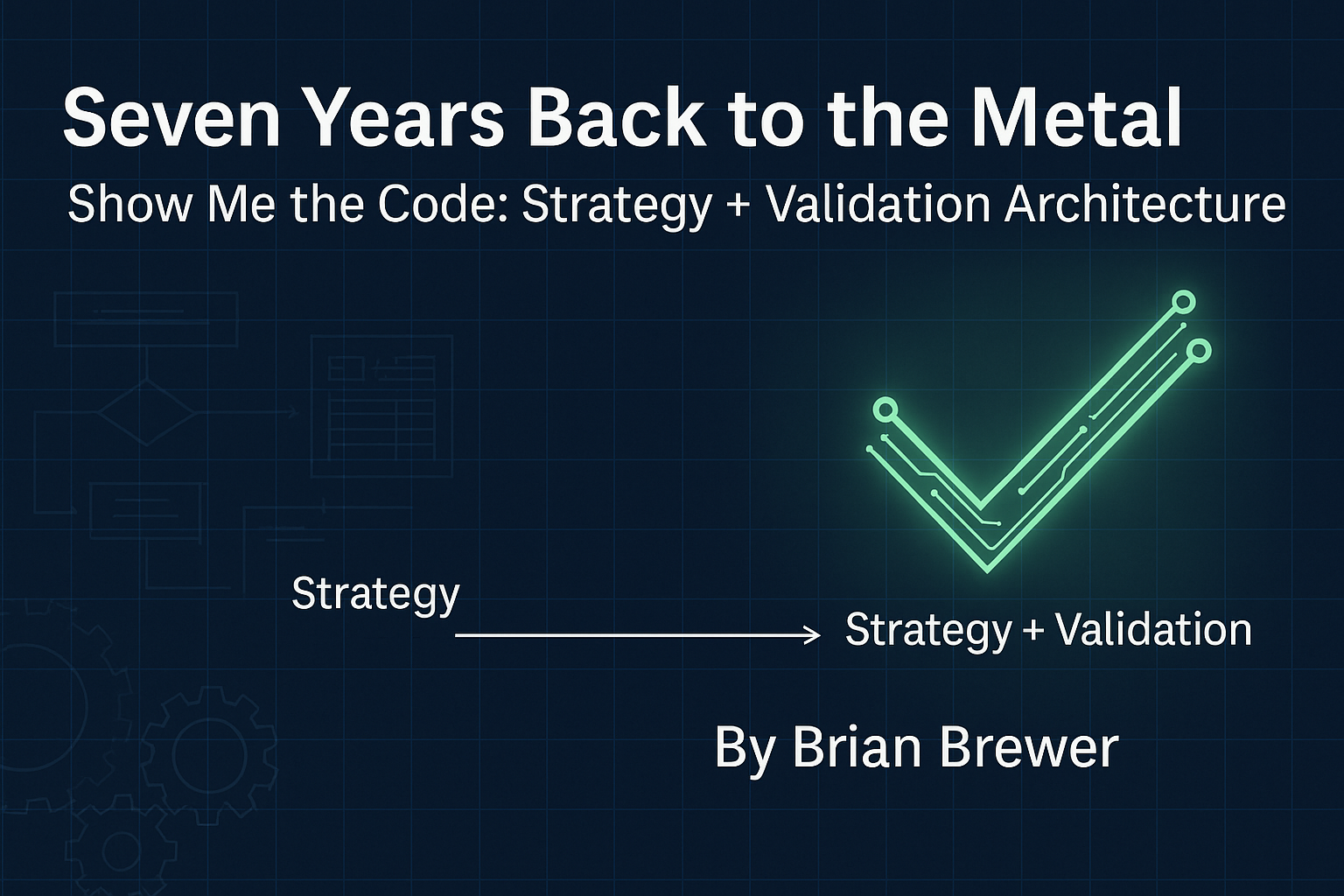
Seven Years Back to the Metal: The Evolution from Strategy-Only to Strategy + Technical Validation Architecture
By Brian Brewer | Published September 19, 2025
I was a CTO leading Fortune 100 data initiatives in the early 2000s, architecting complex on-premises solutions: C++ embedded systems, C# SOA stacks for financial data warehouses, and metadata-driven platforms that unified OLTP, data warehouses, and master data management into enterprise coherence. We designed solutions, debugged complex issues, and owned accountability—because strategy without validation breaks SLAs and careers.
Then came the pivot. In 2018, a $1M tech debt crisis at a major client exposed a critical gap: brilliant architectural vision undermined by execution disconnect. Siloed metadata, tangled SOA dependencies, and governance strategies that remained PowerPoint promises while teams struggled with legacy complexity. With 20+ years of experience, I chose integration over isolation: back to hands-on learning, back to implementation trenches, back to proving architecture through working code. This seven-year evolution (2018–2025) isn’t just a personal journey—it’s a blueprint for why strategic architects who maintain execution fluency deliver where pure strategists struggle.
The Evolution Timeline: From Strategy-First to Strategy + Execution Leadership
2018: The Crisis That Redefined Architectural Leadership
While winding down InfoLibrarian™—my 15-year metadata platform (2005–2020)—I had proven strategic impact across 30+ Fortune 500 implementations: automated lineage reducing GDPR compliance risk by 50% for a travel tech giant, PHI catalogs ensuring healthcare regulatory alignment, and real-time metadata boosting media platform launches by 25%. But that $1M crisis revealed the modern challenge: my proven C++/C# architectures excelled on-prem, yet cloud transformation demanded hands-on fluency with PySpark pipelines, event-driven Kafka, and Infrastructure-as-Code. I pursued advanced MPP Big Data/Data Science programs, earned AWS/Azure certifications (Solutions Architect, Data Analytics Specialty), and built working Python prototypes—not to replace strategic thinking, but to validate it through executable proof-of-concepts.
2020–2025: Multi-Cloud Leadership Through Strategic Validation
From 2020 to 2025, I led complex multi-cloud data initiatives by rolling up my sleeves to validate architectural decisions: diagnosing why petabyte-scale Databricks Delta Lakes underperformed through hands-on POCs, prototyping Synapse query optimizations to prove performance improvements, and building MVP self-service catalogs that demonstrated 30% BI onboarding improvements before full implementation. As the architect willing to code reviews, build proof-of-concepts, and validate solutions through working prototypes, I bridged strategic vision with technical validation—testing PySpark patterns, prototyping data contracts in dbt, and proving governance models actually worked before teams committed to full builds.
This strategic-validation approach evolved into the Governed Data Platform™ and Serverless Data Lake Catalyst—proven frameworks combining DAMA best practices with cloud-native patterns validated through working MVPs. I prototyped GenAI-driven processes (proving 20%+ efficiency gains before scaling), built reusable architecture patterns that reduced POC-to-production time from years to months, and validated enterprise ML/AI/data modernization approaches using comprehensive tool stacks: Glue, IAM, PySpark, Airflow, dbt, SageMaker, OpenSearch, Bedrock, Lambda, and Step Functions. This validation-first approach contributed to industry recognition (Migration Consulting Partner of the Year, Global 2024) while chairing principal architecture communities focused on proven patterns.
In May 2025, I launched Data Trust Engineering (DTE), an open-source framework with 19+ architectural patterns for trust dashboards, pipeline certifications, and AI safety controls—validated through working prototypes with real-time trust metrics and rollback mechanisms. The framework includes data-driven governance dashboards built in Python with Streamlit, providing interactive visualizations for data quality, lineage tracking, and AI model performance monitoring. Currently advancing AI expertise through agent architecture and RAG 2.0 coursework, prototyping frameworks for GraphRAG, Neo4j knowledge graphs, and privacy-compliant AI evaluation patterns that teams can adapt for production.
Why Strategic + Execution Architects Win in 2025: The Evidence
Gartner’s 2025 research warns that 30% of generative AI projects will be abandoned post-POC by year-end, with 40% of agentic AI initiatives cancelled by 2027—primarily due to architectural gaps and implementation reality checks. The emerging agentic RAG paradigm—combining autonomous agents with retrieval-augmented generation—demands both strategic architectural vision AND hands-on implementation expertise to navigate multi-agent system complexity.
Traditional strategy-only approaches struggle here. Modern data architecture requires semantic layer design, agentic mesh orchestration, and real-time AI-data feedback loops. Executives who can architect the roadmap AND validate through working prototypes avoid the failure statistics. As one Fortune 500 CTO recently told me: “I need architects who can both design the solution and prove it works through POCs before we bet the budget.”
However, successful technical validation requires well-defined use cases to avoid code churn and scope creep in prototypes. This is where strategic consulting expertise becomes crucial—defining clear problem boundaries, success metrics, and testable hypotheses before any code is written. The combination of strategic problem definition with hands-on validation creates the most effective approach: precise use case scoping followed by focused prototype development that proves architectural decisions without endless iteration.
This translates to prototyping complex integration patterns—LangChain orchestration MVPs, Airflow scheduling proofs-of-concept, Kafka streaming validators—governed by policy-as-code frameworks. My client portfolio demonstrates results through validated architecture patterns, not untested theoretical frameworks.
Executive Operating Principles: Bridging Strategy and Technical Validation
- Scope Before You Code: Define precise use cases with clear success metrics before prototyping—strategic consulting expertise prevents scope creep and code churn in validation cycles.
- Prototype Strategic Decisions: Validate architectural choices through working MVPs—build thin-slice RAG retrieval POCs over 1-2 sprints, measure latency and accuracy before committing enterprise budgets.
- Build Data-Driven Governance: Create interactive dashboards in Python/Streamlit for real-time data quality monitoring, lineage visualization, and AI model performance tracking.
- Validate Governance Through Code: Test policies via Terraform/Bicep prototypes, prove compliance patterns through IAM rule validation in controlled timeframes, not just documentation.
- Architect Data as Product: Version schemas in Git, prototype contract testing in CI/CD environments, validate end-to-end lineage with OpenLineage POCs within reasonable development cycles.
- Prove Patterns End-to-End: Design from ingestion (Glue prototypes) through consumption (agent framework MVPs via Semantic Kernel/AutoGen) with realistic sprint planning.
- Measure Prototype Impact: Track trust scores in POCs over adoption surveys; validate unit cost per insight, defect rates, and recovery patterns through focused validation sprints.
The Strategic Advantage: Technology Leadership Through Validated Architecture
Seven years ago, I chose evolution over stagnation—integrating hands-on validation with strategic vision. This humbled my assumptions, refined my judgment through working prototypes, and accelerated my impact. As DTE founder and InfoLibrarian fractional CTO, I deliver trust-enabled architectures with quantified AI risk management—validated patterns and POC frameworks that clients can adapt, customize, and scale to production.
Strategy creates the vision. Prototype validation proves the path. Architecture that combines both delivers sustainable competitive advantage.
The future belongs to leaders who can both envision the destination and validate the journey through working prototypes. In today’s AI transformation landscape, strategic architects who maintain technical validation capabilities don’t just survive—they create sustainable competitive advantages.
Key Insights for Technology Leaders
- “Strategy without validation through working prototypes is expensive guesswork.”
- “The $1M crisis taught me: Architectural vision requires proof through realistic development cycles.”
- “Strategic consulting defines the use case; hands-on validation proves the architecture—both are essential to avoid prototype scope creep.”
- “Modern CTOs architect through validated MVPs, not just conceptual frameworks—give me at least a sprint to prove the pattern.”
- “In AI’s complexity flood, technical validation fluency isn’t optional—but it doesn’t require superhuman speed.”
Next Steps
Explore the Data Trust Engineering framework at github.com/datatrustengineering, or connect with me on LinkedIn to discuss your AI transformation challenges.
Ready to bridge strategic vision with technical validation? Let’s architect solutions that work.
About the Author
Brian Brewer brings 20+ years of technology leadership, founding InfoLibrarian™ (2005–2020) and currently leading Data Trust Engineering while serving as fractional CTO for AI transformation initiatives. His strategic-validation integration approach enables architectures that deliver measurable business impact.

